Is it the right choice for your next mobile app project?
Introduction
When it comes to the advantages and disadvantages of Node.js, the consensus is pretty clear. Programmers love working with it. And it’s easy to see why. As a backend run-time environment, Node.js allows developers to load up mobile apps with simultaneously running functions without crashing or slowing the servers. And as a bonus, it runs on JavaScript, one of the easiest-to-use, most popular programming languages in the world.

While Node.JS is hardly the only programming environment running on JavaScript, it is definitely the most widely adopted. This recent graphic from Statista shows, mobile app developers prefer it by a large percentage over other alternatives, with more than 49 percent of those surveyed saying they regularly use Node.js.
In this article, we’ll discuss the pros and cons of Node.js and take a deep dive into what the technology can do for your latest mobile or web application. Whether your app needs to run on tablets or smartphones, this runtime environment can provide you with the firepower you need to build truly supple, complex, immersive mobile apps. Let’s discuss how.
What is Node.js?
It is a free, open-source, cross-platform runtime environment that runs on JavaScript. Meant mainly for the server side, or client side, of a mobile application, it is a full-stack development environment that divides up tasks into fully separate “nodes.”
When people ask, “what are the advantages of Node.js,” its structure is the reason we give them. It is, after all, the primary reason why it was created, and a whole ecosystem of dedicated, open-source modules was created around it.
Whether you’re developing apps for the iPad, iPhone, or Android, nodes are what makes this environment so useful to programmers. Because each task is separated into independent, separate node paths, tasks can run simultaneously and seamlessly together, without bogging down the server or using up too much capacity.

A Node refers to this as a “microservice” pattern, with each a self-contained pathway to fulfill a particular service. It’s an innovative way of breaking an app down into its smallest bits. But it’s a very efficient way to handle mobile applications, which need speed, accessibility, and accuracy above all.

This chart represents how a typical application might be organized. See how everything is organized as a spoke off the core app programming? Functions like customer email, or shopping carts, or portal requests are given their own “node.” And those self-contained areas can run without interfering with each other, or the core application itself.
This structure has specific implications for the framework. Because of this capability, Node.js has a key advantage — the ability to run on a single thread, using non-blocking I/O calls. This allows it to handle tens of thousands of concurrent threads, held in an event loop.
It’s important to note here that Node isn’t the only single-threaded framework out there. But it is one of the most widely used and popular. And it’s important to understand how this key benefit can work for you.
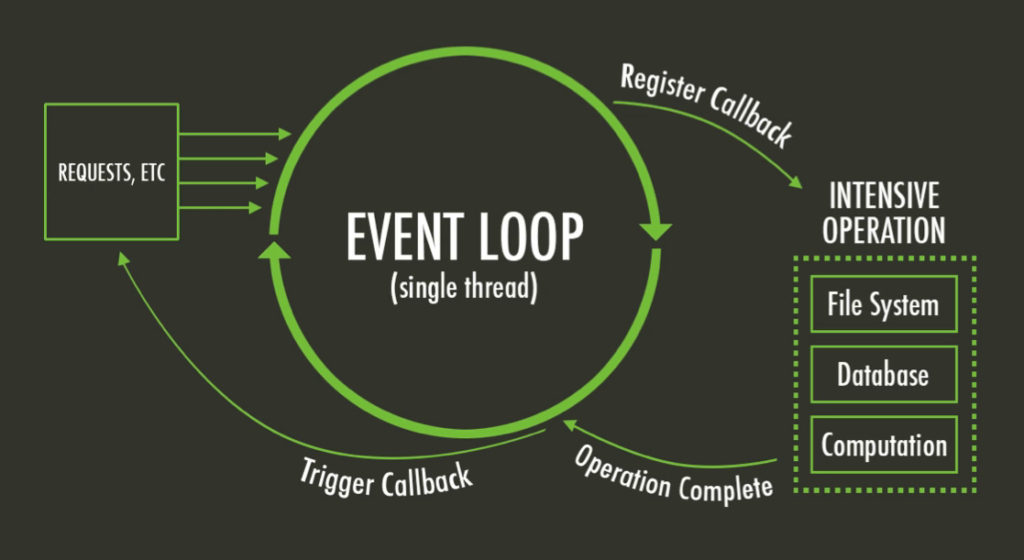
So how would this play out in the real world? Let’s imagine for a moment, that you have developed a fitness app that has several key areas: user monitoring, online video classes, online payment, and email marketing/CMS. Some areas will get more traction than others. Some users may not use the monitoring section, for instance.
The obvious solution would be to scale the area that is getting the most use. But for many monolithic app development systems, this is impossible. But its ability to scale selectively is one of the key benefits of Node.js.
Functionality like this makes it a favorite among developers of large, immersive apps like mobile games, entertainment, banking or any app that needs a lightweight, scalable solution.
And its simplicity can be beneficial to web development and web design, too, especially as mobile apps for iPhone, Android or iPad interact with a client’s web environment. Its speedy processing makes it possible to push UI/UX development to new levels. When it comes to using this particular run time environment for your mobile applications, there are a lot of Node.js pros and cons to consider. We’ll help walk you through the most important points.
Advantages of Using Node.js
As you evaluate the pros and cons of Node.js for your next project, of course, it’s important to understand just how powerful this run-time environment can be. Stay with us here — the list of Node.js advantages is long, but an important part of understanding your development plan. And it’s important that you hire Node.js developers who understand how to make the most of those advantages. In order to do it well and avoid mistakes, you have to prepare Node js interview questions for job interviews very carefully.
- The ability to scale up quickly — Each of the nodes in Node.js is based around an “event.” A customer buys an in-app purchase, or sends an email to customer service, for instance. The amount of nodes you can add to your core programming function are nearly limitless. This means you can scale vertically, adding new capability paths that lead back to your core application code. Or, you can scale horizontally, adding new resources to existing programming. Either way, scalability gives your application room to grow, and that’s one of the key benefits of using Node.js.
- Speed and Performance — Its non-blocking, input-output operations make the environment one of the speediest options available. Code runs quickly, and that enhances the entire run-time environment. This is largely due to its sectioned-off system. But it also has to do with the fact that it runs on Google’s V8 JavaScript engine. Its apps are more likely to be programmed end-to-end in Javascript, and that plug and play interoperability contributes to speed and performance.
- Flexibility — In a discussion of Node.js pros and cons programming flexibility is perhaps the biggest benefit of all. When you make a change in Node.js, only that node is affected. Where other run time environments or frameworks may require you to make changes all the way back to the core programming, it doesn’t require anything more than a change to the node. And that is great not just for your initial build, but for your ongoing maintenance as well. And best of all, when you combine JSON with Node.js, you can easily exchange information between client servers and the webserver. Programmers can also use APIs to build TCP, HTTP, DNS, etc. into the server.
- The accessibility of a single programming language — Because it Is powered by JavaScript, programmers can easily tie nodes into the rest of the full-stack development. This makes it easier for front-end developers to take on more difficult back-end programming tasks. No other server-side languages are necessary. And that’s a good thing because it speeds up development processing in almost every area and allows programmers of all levels easier access to your mobile apps’ back end. It’s one of the key benefits of Node.js.
- Efficient caching — In a debate over the pros and cons of Node.js, caching always comes up as a key Node.js benefit. It has a powerful ability to cache data. When requests are made to the app, they are cached in-app memory. Consequently, when requests cycle through execution and re-execution, the nodes are still able to run efficiently and not be bogged down by historical data.
- Fast-to-market-development — Node’s basis in JavaScript brings many benefits to the table, especially the ease at which developers can add more features and predesigned tools and templates. In fact, it has an extensive package management library, with thousands of open-source options that can be added to your app project immediately. These pre-packaged options not only reduce your time to market, but they reduce your programming budget, as well. When evaluating Node’s pros and cons, this is a bottom-line benefit that can’t be ignored.
Get Node.js specialists salaries report

- An active user community — No discussion of Node.js advantages and disadvantages would be complete without discussing the huge benefits of its enormous user community. Many thousands of programmers around the globe belong to this user community, and they are very helpful to each other, providing each other with new, open-source code for every type of mobile application need. If there’s something that’s hanging up your design team, chances are, quick answers can be found through the community.
- Efficient Queueing of Requests — A critical benefit of using Node.js is its ability to handle multiple requests at once. How does it do this? By offering users an optional nob-block I/O system. The system works by giving priority to those requests that take the lowest response time. This prioritization helps speed up the overall running of your app, especially when comparing it to other languages like Python or Ruby on Rails.
- Easy to master — Node JS is easy to learn, primarily because it’s based on JavaScript. This makes it easier for your front-end programmers or designers to learn more complicated server-side programming with ease.

- A better choice for mobile — This may very well be the biggest benefit of using node JS of all. Its fast development times, ease of use, and ability to scale up with increased traffic makes it an indispensable tool for getting your company into the mobile mainstream. If you’re looking to create a healthcare app, for instance, and grow your business with this immersive, fast-running mobile application, Node makes it easy for you. And in today’s rapid mobile deployment environment, this is no small thing.
- Real-time communication — It maintains a steady connection between the user and the server, and that means there’s no lag between what a user asks for, and the server processing the request. While other run-time environments are trying to parse out a message letter by letter, it has already processed the request whole. It’s also important to note that it supports Websockets, one of the industry’s most popular real-time communication solutions. With Node.js benefits like this one, you can ensure users are always in sync with you.

- Node Package Manager for Enterprise — Its many available packages are available free and open-source, over the open web. And that can be a security risk, especially for large, enterprise-level organizations. In the debate about Node.js pros and cons, this decision can be tricky. But we believe it has turned this into an advantage with its package manager for enterprise. The enterprise manager neatly circumvents this risk by allowing the packages to run behind the company’s firewall. It also offers businesses a private registry with high-end security features. This allows the company to identify vulnerabilities, replace unsafe code, and control who can and cannot see their code. Enterprise-level companies looking to hire a dedicated team of Node.js developers should definitely make sure they have experience with its enterprise-level software solutions, and how UX/UI is affected in this environment.
- Cross-platform development — Do you need to have a mobile app that also links to a desktop app? Node has you covered here, too. Much of the code you use for your mobile app can be directly transferred to desktop applications, especially in the macOS ecosystem. And that cuts down on development time and costs significantly. And who couldn’t use that particular Node.js advantage?
Disadvantages of Using Node.JS
When you hire web programmer and then you compile a list of Node.js advantages and disadvantages, the disadvantages are a far shorter list. But no software is perfect, and Node is no exception. The program does have some serious drawbacks that are worth considering.
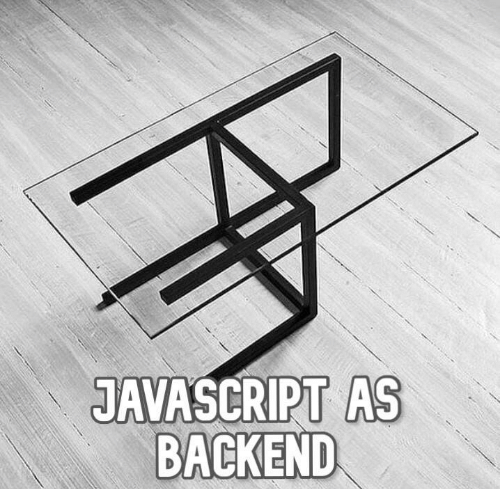
- Inability to process CPU bound tasks quickly — It is considered single-threaded, because it processes JavaScript, which is, of course, single-threaded. Its non-blocking input/output model uses an event loop to process threads asynchronously. And this works great—until Node receives a CPU-bound task. It prioritizes these heavy, CPU bound tasks first, and that results in slow processing and overall delay in the event loop. This is why so many programmers say Node.js is not a good fit for apps that require heavy computation. It’s important to note that in 2018, it rolled out a multi-threading tool called worker threads as part of its 10.5.0 update. This module can leverage additional threads from a thread pool, so heavy parallel processes can be executed on different threads. It’s still considered experimental, but it could go a long way towards alleviating this obvious flaw in the future. Still, it’s one of Node’s pros and cons you have to weigh very carefully.
- Callback hell can put your code in a loop — If you’re keeping a number of queued tasks in running in the background, lookout. You could fall into what Node programmers often refer to as “callback hell.” This happens callbacks get nested several layers deep.
Let’s talk about how that happens. Callbacks are the functions that run after a task is finished. Have too many of these running in the background, and their callbacks can get nested within each other, as is noted in this graphic below. Node’s asynchronous nature is partly to blame for this, but really, it happens when you’re not running clean code, or bad code structures.
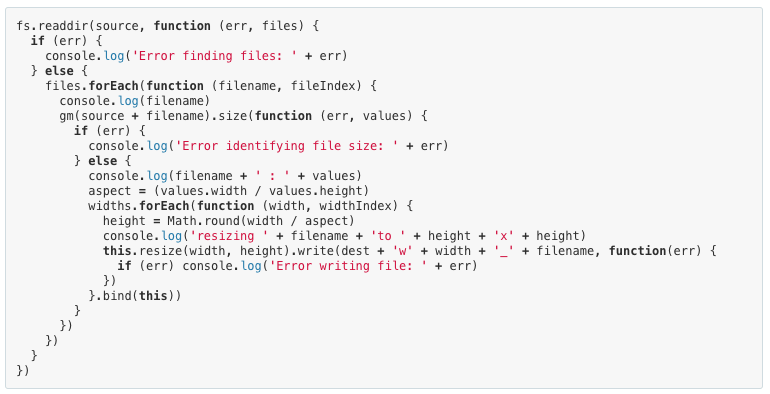
- An overgrown, yet immature npm module registry — Node.js has an enormous user community that has produced thousands of open source modules that are there for the taking. And that’s a problem because it can be very difficult to know if the node you are downloading is a quality program that’s vetted or properly documented. It’s hard to search the community for nodes based on quality or ratings. And with only a portion of its core technology monitored and vetted by Joyent, that can make it hard to find enterprise-ready nodes to use. Do we recommend the community registry? Yes. Do you need to be careful on it? Also, yes.
- Hot competition for Node programmers — While a majority of computer programmers and mobile app developers can program in Javascript, not all of them have the engineering expertise to work with this environment. And that means node developers are a hot commodity, and competition for talent is fierce.
- Unstable API — Its Application User Interface has gone through several changes. And not all those changes are backwards compatible. That means developers have to make changes in the accessible code bases, just so they can maintain compatibility with the latest version of the Node.js API. Sometimes, it’s not exactly ideal.
- A weak library system — In spite of JavaScript’s global popularity, its library system leaves much to be desired. Because of this, programmers often have to take on the support of some of its more complex functions, like XML parsing, processing of images, database operations, or object-relational mapping. It means that several foundational tasks in Node can be hard to implement.
Examples of Real Projects Using Node.js
Roth River
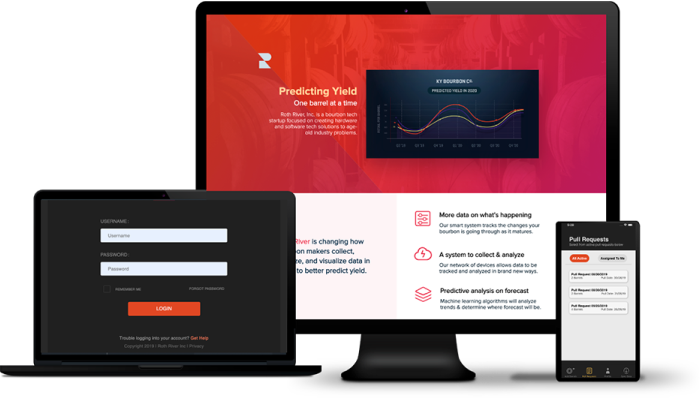
When Roth River was looking to build a cutting-edge CRM interface for its custom distilling company, it came to ProCoders. We were able to help them build a responsive user interface that allowed its members to control every aspect of the bourbon they order, from the beginning to the end of the distilling process. This Node-powered app became an important part of the company’s customer experience and product, connecting front end to back end operations, seamlessly.
FrontEgg
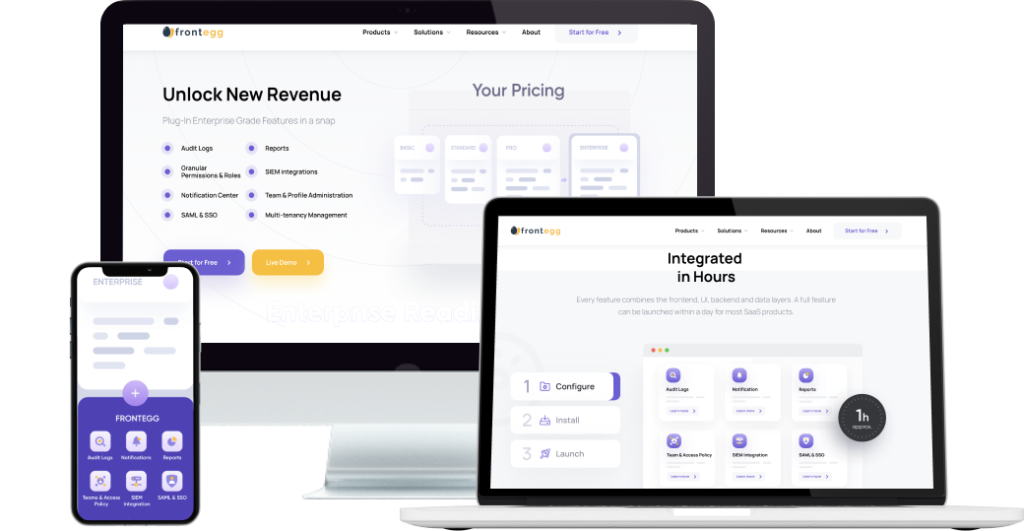
Based in Israel, FrontEgg came to ProCoders with a concept — offering plug-and-play coding and processes for other developing SaaS companies. ProCoders gave FrontEgg the programming firepower to build out its systems, using Node to build out its product offerings as well as its customer-facing web applications. The partnership with FrontEgg continues as ProCoders provides a permanent outstaff talent pool for the company.
Tasks to Use Node.js
So, as you can see, there are some types of app development projects that are better for Node.js than others. In any discussion of Node.js advantages and disadvantages, it’s important to understand the type of tasks that run best in this environment. Here’s ProCoder’s picks:
| Multi-player game apps | Its quick response makes it ideal for communicating with other players and running many kinds of functions. |
| Social media and messaging apps | Social media needs are usually lightweight from a programming perspective, yet versatility is needed, too. And the advantages of Node.js will play well here. |
| Virtual emulators/terminals | The immediate looping feedback needed for a 3D virtual environment works well In Node.js. |
| Collaboration tools | In any communication platform where streaming is needed, there will be many benefits of using Node.js. |
| Apps with asynchronous functions that don’t have to tie back into the CPU | Are you running an entertainment app with lots of offerings? A fitness or health app with several functions? An education app that has user profiles as well as an extensive database of courses to take? All these types of apps could benefit from using Node.js. |
Tasks Not to Use Node.js
Node is a flexible, scalable, lightweight runtime environment that has earned its popularity well. But when you truly answer the question “what are the advantages of Node.js,” you often find that this run-time environment isn’t the right fit for every project. On these types of projects, you really shouldn’t use this Node:
| Apps with Significant CPU-Driven Computation | In general, it uses an event-based, non-blocking I/O model that uses a single CPU. So that means if you are developing an intense CPU processing activity it will block your incoming requests. The app will slow down and eventually get held up in its own number-crunching threads. And all its speediness and efficiency—perhaps the most important benefit of Node.js— will be nullified. |
| Apps that are already simple, using CRUD or HTML | Node.js’ benefit comes from its ability to run several tasks at once. If your app is already streamlined and has only a few functions, you won’t gain any efficiencies using Node. Stick to more straightforward options and leave Node for more complex apps. In this case, you may do better with Angular.js, PHP or Ionic. In the debate over Node.js pros and cons, it will never win on this point. It simply doesn’t add to the app’s performance. |
| Apps requiring relational data access | While there are many benefits of Node.js, its backend relational database tools aren’t one of them. Its database tools aren’t nearly as robust as other frameworks toolboxes, such as Ruby on Rails. This article has already discussed why Node.js underperforms in the area of running backend computations. Other programs can offer far better tools, such as data mappers, active record data-access layer implementations, out of the box data access setup, and more. |
What About Node.js Usage for the Enterprise or Startup?
In this story, it has already been established that there are many advantages and disadvantages of node JS, especially for mid-sized companies. But what are the advantages of Node.js for enterprise-level companies and companies just starting out? Let’s take a look at the pros and cons of Node.js, through the lens of their business challenges.

First, let’s talk about enterprise corporations. Even large companies need scalability, speed, and ease of use. So, it really is no mystery why the node JS foundation was created. Joyant, its creator, wanted to enable widespread adoption and accelerate node JS development across every industry sector. And the industry has responded.
Major companies using this run-time environment JS include IBM, Microsoft, PayPal, Fidelity, and SAP, who serve as the founding members of the organization. Nearly 300 well-known companies now belong to the foundation including Medium, Trello, Uber, and Zendesk, as a start. As long as corporations stay away from the use-cases that don’t match up with Node’s strengths, there should be no limit to what they can accomplish with it.

As for startup companies, there are many advantages of using Node.js. Its natural strengths play well with the startups’ need to be agile and easy to scale. The open-source environment available to programmers will help startups keep their development costs down. However, to calculate budget of your project properly, you need to know Node.js developer salary. And the environment’s reliance on JavaScript makes maintenance and interoperability far easier.
Nodes fast speeds and easy ability to switch nodes make it perfect for developers who need to test out new ideas and services. In many ways, it’s a lot like have bought a modular house that allows you to add sections on as you need them. It allows companies to scale up as they need and what could be a more important Node.js benefit for a start-up?
Conclusion
So, when you’re trying to evaluate the advantages and disadvantages of using node JS try to keep these things in mind. It offers:
- Faster than monolithic apps
- Single-threaded, but runs synchronously
- Is both vertically and horizontally scalable
- Has a wide variety of open-source code and a vibrant user community
- Offers the ability to reuse code
- Is trusted by thousands of corporations, including some of the world’s largest
- Is very popular with programmers

